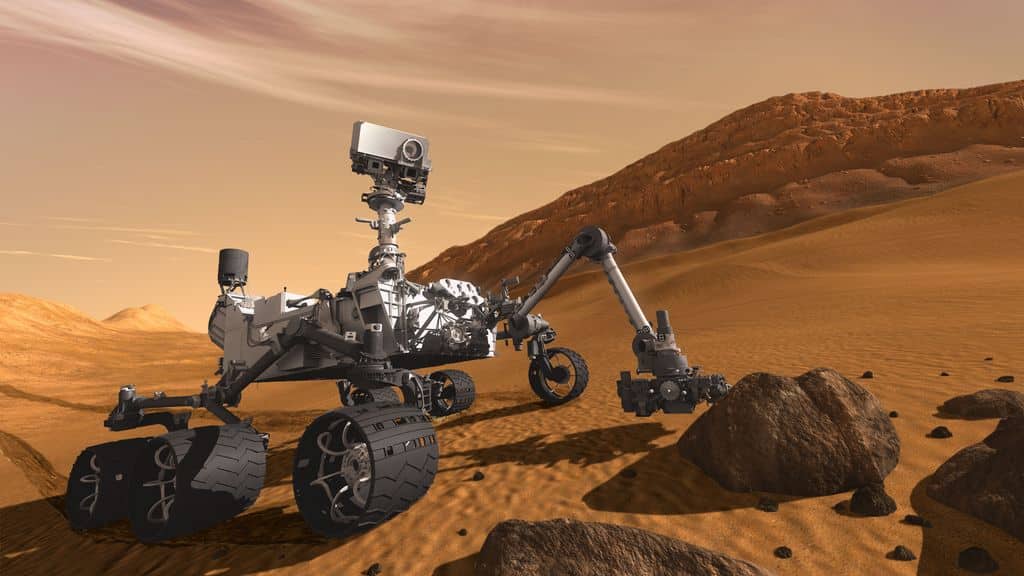About Mars Curiosity Rover
- It is a U.S. robotic vehicle designed to explore the surface of Mars.
- It was launched aboard an Atlas V rocket from Cape Canaveral Air Force Station, Florida on Nov. 26, 2011, and landed on Aug. 5, 2012, after taking eight months and 10 days to reach the Red Planet.
- The rover is currently roaming Mars’ landscape looking for signs of life and learning about the Red Planet’s unique environment.
- The rover is part of NASA’s Mars Science Laboratory mission which tested a novel landing method that saw the spacecraft descend on a parachute before its landing system fired up its rockets and hovered as the rover was lowered down onto the surface.
- Features:
- It is about 3 metres long and weighs about 900 kg.
- It does not rely on solar cells for its energy needs but rather draws its electric power from a thermoelectric power generator, with the heat source being the radioactive decay of plutonium and the heat sink being Mars’s atmosphere.
- According to NASA, Curiosity has four main science goals in support of the agency’s Mars exploration program:
- Determine whether life ever arose on Mars.
- Characterize the climate of Mars.
- Characterize the geology of Mars.
- Prepare for human exploration.
What is NASA’s Perseverance rover?
- It is a robotic explorer to land on Mars as part of NASA’s ongoing Mars 2020 Mission.
- Main Job: Seek signs of ancient life and collect samples of rock and regolith (broken rock and soil) for possible return to Earth.
- The rover will collect samples of rock and soil, encase them in tubes, and leave them on the planet’s surface to be returned to Earth at a future date.
- Launch: It was launched on July 30, 2020 from Cape Canaveral, Florida.
- Landing: Successfully landed on the surface of Mar’s Jezero Crater on Feb. 18, 2021.
- Features:
- It is about 3 metres long, 2.7 metres wide, and 2.2 metres tall.
- It is about the size of a car, but weighs only about 1,025 kilograms with all instruments on board.
- Power source: Multi-Mission Radioisotope Thermoelectric Generator (MMRTG). Converts heat from the radioactive decay of plutonium into electricity.
Q1) What is thermoelectricity?
Thermoelectricity, also known as the thermoelectric effect, refers to the phenomenon in which a temperature gradient across a material results in the generation of an electric voltage or potential difference. This effect is a manifestation of the relationship between temperature and the movement of charge carriers (usually electrons) within a conductive material.
Last updated on December, 2025
→ Check out the latest UPSC Syllabus 2026 here.
→ Join Vajiram & Ravi’s Interview Guidance Programme for expert help to crack your final UPSC stage.
→ UPSC Mains Result 2025 is now out.
→ UPSC Notification 2026 is scheduled to be released on January 14, 2026.
→ UPSC Calendar 2026 is released on 15th May, 2025.
→ The UPSC Vacancy 2025 were released 1129, out of which 979 were for UPSC CSE and remaining 150 are for UPSC IFoS.
→ UPSC Prelims 2026 will be conducted on 24th May, 2026 & UPSC Mains 2026 will be conducted on 21st August 2026.
→ The UPSC Selection Process is of 3 stages-Prelims, Mains and Interview.
→ UPSC Result 2024 is released with latest UPSC Marksheet 2024. Check Now!
→ UPSC Prelims Result 2025 is out now for the CSE held on 25 May 2025.
→ UPSC Toppers List 2024 is released now. Shakti Dubey is UPSC AIR 1 2024 Topper.
→ UPSC Prelims Question Paper 2025 and Unofficial Prelims Answer Key 2025 are available now.
→ UPSC Mains Question Paper 2025 is out for Essay, GS 1, 2, 3 & GS 4.
→ UPSC Mains Indian Language Question Paper 2025 is now out.
→ UPSC Mains Optional Question Paper 2025 is now out.
→ Also check Best IAS Coaching in Delhi

















